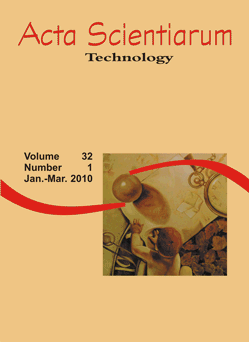<b>Production of emulsifier by a strain of <em>Pseudomonas aeruginosa</em> (C1 LBPVMA-UFAL) using lubricant oil as main carbon source</b> - DOI: 10.4025/actascitechnol.v32i1.7548
DOI:
https://doi.org/10.4025/actascitechnol.v32i1.7548Palavras-chave:
Pseudomonas aeruginosa, biosurfactant, lubricant oil, emulsifier activity, agro-industrial effluentResumo
The intention of this work was to evaluate the growth of Pseudomonas aeruginosa (C1 LBPVMA-UFAL) on lubricant oil and verify the production of rhamnolipid biosurfactant. Tests in solid medium containing lubricant oil supplemented with different sources of nitrogen were used to evaluate the growth of P. aeruginosa. The growth medium used for production of rhamnolipid was (g L-1): yeast extract, 0.1; NaCl, 1.0; MgSO4, 0.2; MnSO4.H2O, 0.02; 0.5% lubricant oil (w v-1). The biosurfactant concentration was detected 24h after the inoculation, during the exponential phase, with the maximum value obtained up to 120h, although no drastic alteration of pH had been verified. The emulsifier activity was also first detected after 24h of incubation, with maximum production after 120h. The characterization of the produced biosurfactant was performed through thin layer chromatography, which showed the presence of two spots with Rf values equal to 0.71 and 0.5, revealed by reagents specific to rhamnolipids. These results suggested that two types of rhamnolipidic biosurfactant are produced by the strain of P. aeruginosa in limited conditions of nutrients, able to use lubricant oil as main carbon source. This bacterium, isolated from agro-industrial effluent, showed potential to bioremediation assays of contamination with petrol and his derivates.Downloads
Downloads
Publicado
Como Citar
Edição
Seção
Licença
DECLARAÇíO DE ORIGINALIDADE E DIREITOS AUTORAIS
Declaro que o presente artigo é original, não tendo sido submetido í publicação em qualquer outro periódico nacional ou internacional, quer seja em parte ou em sua totalidade.
Os direitos autorais pertencem exclusivamente aos autores. Os direitos de licenciamento utilizados pelo periódico é a licença Creative Commons Attribution 4.0 (CC BY 4.0): são permitidos o compartilhamento (cópia e distribuição do material em qualqer meio ou formato) e adaptação (remix, transformação e criação de material a partir do conteúdo assim licenciado para quaisquer fins, inclusive comerciais.
Recomenda-se a leitura desse link para maiores informações sobre o tema: fornecimento de créditos e referências de forma correta, entre outros detalhes cruciais para uso adequado do material licenciado.















